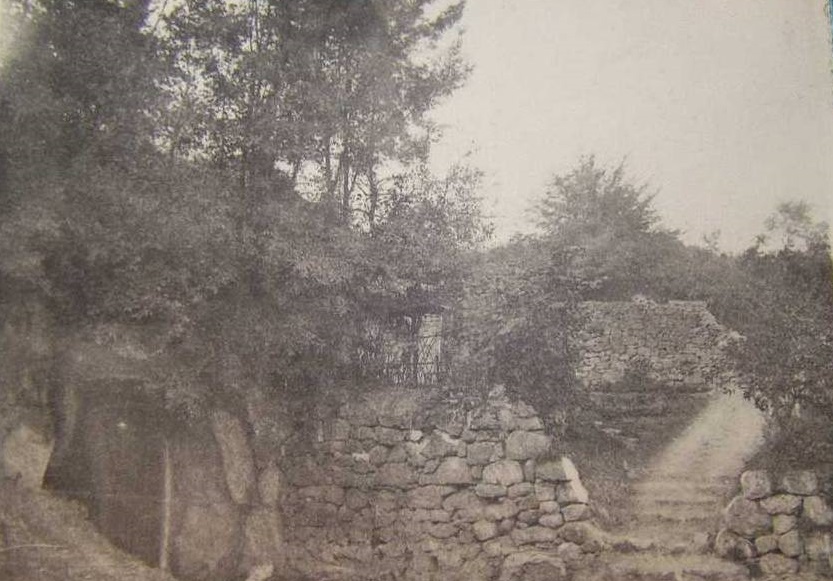Campaign History of the 151e Régiment d'Infanterie - XXVII
~ 1918 ~
Second Battle of the Marne (18 July - 10 August)
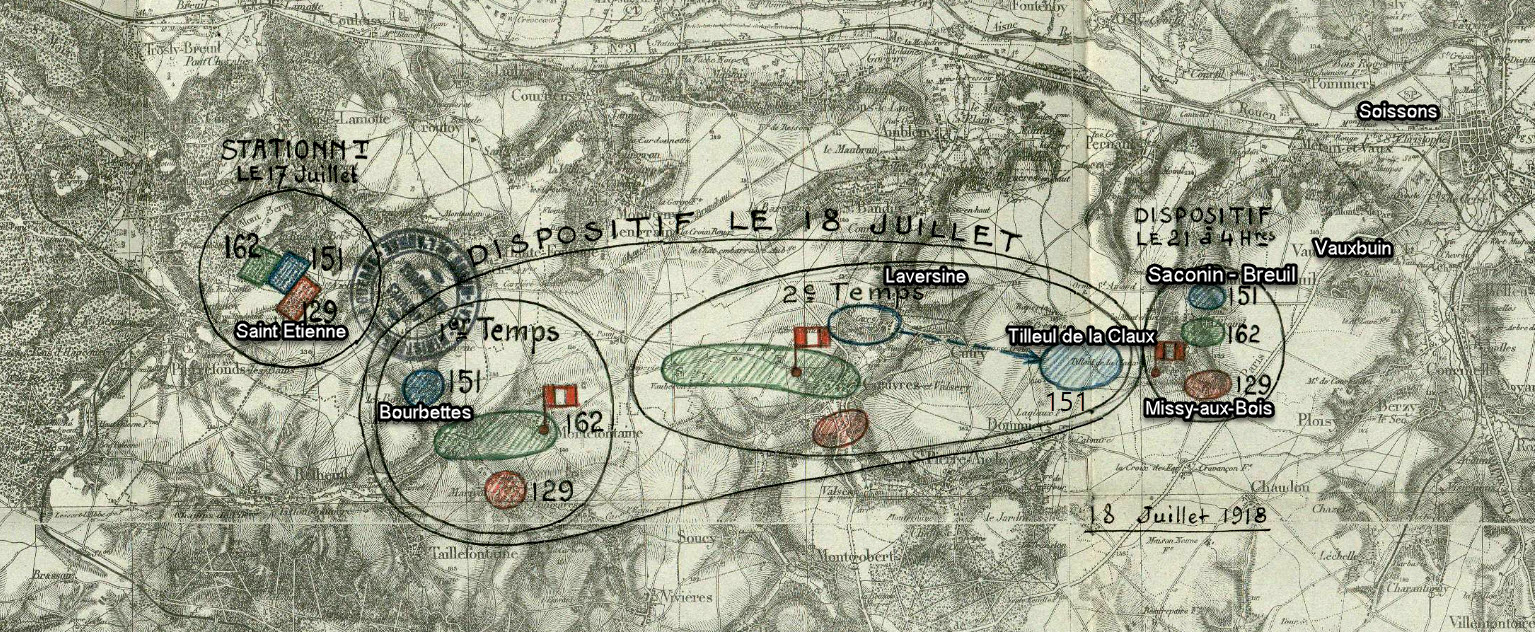
Map showing movements of the 69 DI, 17-21 July 1918 (source: JMO 69 DI).
17 July: With the final German offensive of the spring being quickly brought to a halt, it was now the Allies turn to strike in the torrid heat of summer. The regiment departs its billets at 0300 hrs and marches to the woods northwest of Saint Etienne Roilaye to bivouac. It's effective remains very depleted with few reinforcements having arrived and Spanish flu leading to many sick cases. Order of march is 1, 2, 3 Bats., then CHR. Before midnight, the 69 DI (attached to the 10th Army) forms up into formation on Vandy spring to the south of Choues. The US 1st Division is in front of the 69 DI, while the 72 DI is on its left. The 151 RI receives orders to proceed to the Bourbettes heights, the 162 RI (on its right) to Roy Saint Nicolas and the 129 RI (to the right of 162 RI) to Mortefontaine. At 2130 hrs, the units set off, with the 1 Bat (in the lead) positioning itself 300 meters to the east of the Bourbettes road, Roy Saint Nicolas in the ravine leading to Côte 146. The 2 Bat. is on the Beronge road on Côte 146 in the woods on the western slopes of the plateau. The 3 Bat. is on the west bank of the Bourbettes heights. Just as the regiment set off in the evening, a strong thunderstorm bursts in the skies above, bringing torrential rain. Sdt. August Bordinat recorded:
Had the night been clear, the enemy aircraft would surely have noticed all these movements. But rarely had we seen such a powerful storm and it is after dealing with a thousand troubles that we managed to get out of this forest. We couldn't see the sky nor ground, blinded by the lightning that for now was proving our savior. After many somersaults and tumbles, we finally get out and the infantry must cross over the fields, the roads being quite crowded with other weapons [cannons, tanks, vehicles] of all kinds. Soaked to the bones, at daybreak we arrive in a hole called the Bourbettes, and shelter in some houses.The 1 and 2 Bats. report they are in position at 0440 and 0130 hrs respectively.
18 July: At dawn, 10th Army attacks the enemy positions advancing southeast in the direction of Fère-en-Tardenois. The 69 DI is placed behind the US 1st Division, in the wake of which it will march in order to exploit any success. The attack progresses quickly and at 1145 hrs, the 151 is ordered to assembled in the area around Laversine, the movement being done in columns by successive battalions, each battalion being in a double column (in the order of 1, 2, 3 Bats.). The march is proceeded by a cavalry patrol that is informed of the route itinerary. At 1600 hrs the situation is as follows: 153 DI and the US 1st Division (in front of 69 DI) have made great progress, advancing up to the Montagne de Paris southwest of Soissons and occupy a line going from this height in the direction of Missy-aux-Bois up to Ploisy. By 1645 hrs, 1 Bat. is in the Bois "Le Chaufour", 2 Bat. on the western edge of Laversine behind the windmill, 3 Bat. in the quarries 600 meters west of Laversine. A half company of engineers is put at the disposition of the regiment. The 1 Bat. probes towards Côte 138, situated about a kilometer west of Saconin. The 2 Bat. detaches a section to the north of Laversine and a half-section to the bridge on the Cutry road. The 3 Bat. detaches a section to the crest between the valley and Côte 137 and another to Côte 137.
Owing to the advance of the 153 DI and the US 1st Division, the 151 progresses to Tilleul de la Claux with the mission of opposing any enemy resistance encountered along the Soissons – Paris road. The 1 and 2 Bats. are in the lead and march alongside each other in double column, ready to engage the enemy, the 3 Bat. marches behind them in the center. Columns of German prisoners lead by American troops march past them to the rear. The lead battalions stop at the Saconin – Missy road, while 3 Bat. halts when its head reaches Tilleul de la Claux, where the colonel sets up his PC. A half platoon of cavalry is put at the disposition of the regiment and provides a liaison patrol near the ravine of Côte 150 with scouts from the regiment. A half company of engineers is assigned to 3 Bat.
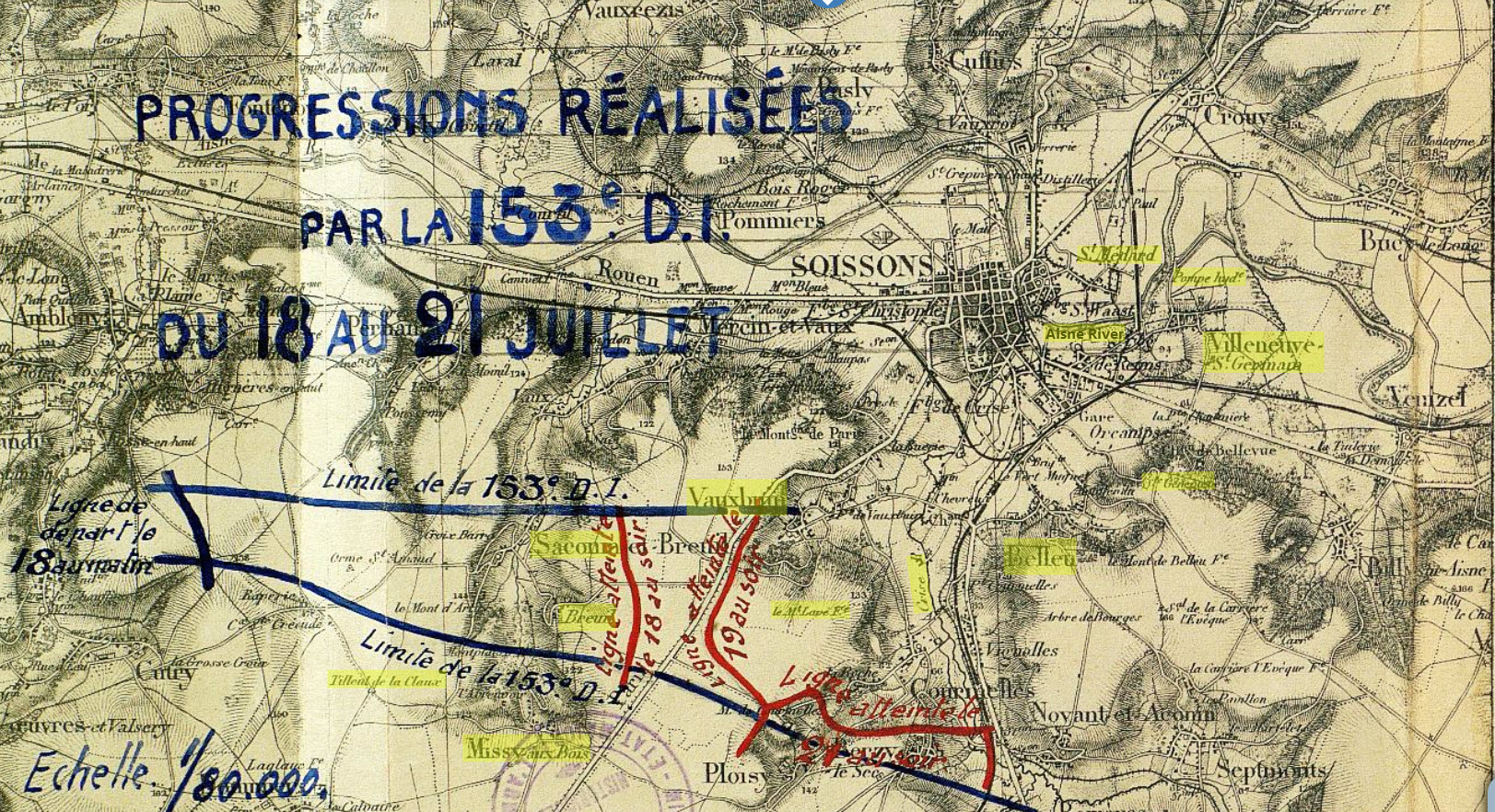
Map showing the fighting sector of the 69 DI, 18 July - 25 August 1918 (source: JMO 153 DI. Original map is here).
19-24 July: The next day is bright and clear. The general attack resumes at 0400 hrs. The 1 and 2 Bats. are still behind the US 1st Division with the same mission as before, as well as intervention in case of enemy counter-attack. Orders arrive from the 153 DI requesting that the 151 provide a battalion to support the attack scheduled for 1700 hrs. The heat of the day is only exacerbated by terrible thirst, as the men’s canteens are now empty of water. Though there is a stream (Ru de Retz) that runs through Valsery, the bodies of German dead and slaughtered horses choke the stream, contaminating the water. Nearby wells are also found to be contaminated. Sous-Lieut. Roger Basteau recorded the progress:
Along each side of the road there are the bodies of German dead and horses. There are some broken down English tanks on the low side of the road. Positioned up on the plateau, we advance in dispersed order so as to avoid being spotted by enemy planes and observers...The 1 Bat. is sent in compliance to the area of Breuil and the Ferme de Mont d’Arly with orders to engage if attacked by the enemy. During its movement it has to cross through two enemy artillery barrages but manages to make it through with only minor losses (2 killed and 6 wounded). The battalion enters the Saconin - Breuil ravine along the Ferme de Mont d'Arly road, occupying the northeast portion of the ravine in a thick coppice of trees. The Regiment stops for the evening taking shelter in rudimentary trenches dug with portable entrenchment tools. Boridnat describes the scene in the evening:
On a very different night from the previous one, our way is illuminated by the bright moon and the enemy, now aware of our designs, launched his aviation on our vital rear services. With the help of flares, they seek to reach and paralyze their effectiveness. But despite the bombs, nothing stops this determined hive.Losses on 19 July include 6 killed and 19 wounded (incl. Lieut. Dupré and Sous-Lieut. Houdin). The regiment’s mission remains the same the next day, though no movement is made. Lieut. Dievart takes command of 1 MG Co. Losses on 20 July include 3 killed and 12 wounded (incl. Capt. Wébanck – 1 MG Co.).
The French 10th Army continues the attack between the Aisne and the Ourcq the following day. The 69 DI is put at the disposition of I CA which is participating in the offensive. It’s mission is to take the Belleu plateau after surpassing the 153 DI. On 21 July, the regiment receives orders to reassemble at 0400 hrs to the north of Breuil, however the mission is canceled ultimately. In the night of 21-22 July, 2 Bat. relieves a battalion of the 153 DI, positioning itself at the northeast entrance of Breuil at 0030 hrs on the Breuil – Vauxbuin road. The 1 Bat. positions itself on the west bank of the Saconin ravine (just northest of Saconin) in the area of St. Amand elm tree where it places itself in third line. The 3 Bat. remains in its positions in second line. The colonel’s PC is in the quarries 300 meters northeast of the Ferme St. Laurent. Losses include 14 killed and 13 wounded. Included among the dead is the famous stretcher-bearer Charles Leon Henon, and Sous-Lieut. Roudant (9 Co.) and Médecin Aide-Major Maupin are wounded..
In the night of 22-23 July, the 2 Bat. relieves 1 Bat., which is completed just before dawn after great difficulties. The 5 and 6 Cos. are in the first line, 7 Co. is in support. The division’s mission continues to be one of attack, specifically to take Mont-Lavé. At 1330 hrs 2 Bat. is ordered to progress with grenades towards Tranchée du G.M.P. held by the enemy, in order to outflank the ouvrage on the plateau south of Vauxbuin. It should not enter the entrenchments themselves. The 3 Bat. detaches in the evening two companies of workers to the first line. Losses include 3 killed and 7 wounded (including Sous-Lieuts. Boulanger and Delancey of 5 Co.).
The night of 23 July is very active, with numerous artillery barrages and a great amount of machine-gun fire. The crossroads and Saconin ravine particularly are systematically subjected to Mustard (Ypérite) gas shells. Losses include 2 killed, 23 wounded (including 11 gassed). On 24 July, the enemy continues to strongly bombard the support positions with Mustard gas. The enemy infantry is nervous and fires machine-guns in abundance. The regiment continues to work on their positions in preparation for the coming attack. Losses include 2 killed, 17 wounded (including 11 gassed). Sous-Lieuts. Miné (1 Co.) is gassed, Sous-Lieut. Ribaud (6 Co.) is wounded and Chef de Musique Hardit (CHR) contracts conjunctivitis from the gas.
25-31 July: The next week will be a rainy period of passing showers that turn the ground into a muddy morass. Despite the warm weather, the men, often soaked to the bone, shiver in their positions. The day of 25 August is calm aside from barrages of poison gas shells. In the night of 25-26 July, 3 Bat. relieves 2 Bat. and will occupy the caves and quarries in the Saconin ravine that had been held by 1 Bat., with 1 Bat. moving to 3 Bat.’s former position. Capt. Pey is promoted to the Chevalier de la Légion d’Honneur. Losses include 4 killed, 25 wounded (including 13 gassed). The next day, 3 Bat. is holding the first-line trenches as follows: 11 Co. on the right, 10 Co. on the left, 9 Co. in support. Owing to a strong bombardment with poison gas shells in the Saconin ravine, 2 Bat. becomes greatly disorganized., the 7 Co. and 2 MG Co. are entirely depleted of manpower. Sous-Lieut. Basteau (5 Co.) recorded the incident:
This part of the relief is carried out under a very dense artillery barrage that includes gas shells. We have to constantly put on our masks. The itinerary that must normally follow means having to go through the [Saconin-Breuil] ravine where the enemy shoots poison gas shells. The companies go down and have to ascend the slopes on the other side quickly. Spurred on by the high-explosive shells, some units march too quickly, leading their men to take off their gas masks in order to breath better. Fatal mistake. By the next day a great number had died.Basteau himself will suffer from inflammation of the eyes, blinding him for two days. Work continues on the trenches and transportation of bombs for the trench artillery is carried out. Losses include 6 killed, 57 wounded (including 54 gassed), 1 missing (presumed dead).
On 27 July, the day remains calm but at night the enemy machine-gunners are nervous and fire in abundance. Enemy harassing artillery barrages are fired on the regiment’s lines, while the ravines to the rear are bombarded with poison gas. The situation for 2 Bat. has not improved, with many men suffering from conjunctivitis or inflammation of the eyes, and the number of effectives in the ranks remains low. For the entire battalion there remain only 165 officers and men available. Losses on this day include 26 gassed. Sous-Lieut. Granger is transferred from 7 to 5 Co. Throughout the night of 28 July there are numerous bursts of machine-gun fire. Enemy artillery fire increases. In the night of 28-29 July, 1 Bat. relieves the left battalion of the 162 RI in the first line. Work continues to be pushed as actively as possible in preparation for the coming assault by the division in front, which has now been postponed. Losses include 3 killed, 14 wounded (including 12 gassed), 1 missing (presumed dead). Sous-Lieut. de Loustal is killed and Chereau is wounded.
The next day, 1 Bat. is holding the first-line trenches as follows: 1 and 2 Cos. in the first line, 3 Co. in support. Enemy aviation is very active as soon as it becomes light out. Groups of planes patrol and observe above the regiment’s lines. The enemy displays a great deal of nervousness, with frequent storms of machine-gun fire being unleashed, particularly at dusk and down. Enemy artillery grows even more active, bombarding the ravines. Capt. Labarre (3 Co.) takes command of 1 MG Co. and Capt. Edmond (previously evacuated) retakes command of 2 Co. Losses include 9 wounded (including 7 gassed). During the night of 30 July, enemy artillery becomes active, employing a great quantity of poison gas shells. Work continues on the entrenchements and transporting bombs for the trench artillery. Sous-Lieut. Simonnet is transferred from 3 Co. to 6 Co. Losses include 10 wounded (including 7 gassed). There is much enemy activity during the following day, but the night is calmer. Losses include 8 wounded (including 2 gassed).
A divisional report made in August reports the total losses for the 151 RI in the month of July at 46 killed, 97 wounded, and 137 gassed (280 total).
1 August: Throughout the day the Saconin ravine is bombarded. Work continues at night. Losses include 10 wounded (including 4 gassed).
2 August: At 0700 hrs, after a quiet night, Capt. Caisez (commanding 1 Bat.) telephones to report that the enemy seems to have pulled out of his positions facing the regiment’s front. From 0330 hrs, Lieut. Pfifferling who was leading a group of workers setting up barbed-wire in front of the 151’s lines observed an unusual amount of calm in the enemy trenches – no flares, no gun shots, in contrast to what is normally encountered. Capt. Caisez reports that he has sent a patrol to squared earthworks. At 0800 hrs, Lieut.-Colonel Perchenet orders 1 Bat. to move to the Tranchée du Mont-Lavé, to his right of the Ferme du Mont-Lavé. At the same time, 3 Bat. is ordered to move up to the same trench with its right placed to the left of 1 Bat., its left in liaison with the 2 BCP. At 0830 hrs, 1 Bat. reaches its objective without receiving any enemy fire. At 0840 hrs, 6 Co. is ordered to occupy Tranchée Brunehaut behind the center of the other battalions.
At 0900 hrs, division telephones to say that the 129 and 162 RIs are going to advance. The objective of the division is take the Tranchée du Mont-Lavé. By 0950 hrs, 3 Bat., which occupies this trench, reports that it has sent patrols towards Vauxbuin. At 1000 hrs, division telephones and advises Lieut.-Colonel to be prudent in his progress. As such, he orders the battalions to halt and await for the other regiments of the division to come into line with them. At 1045 hrs, reports arrive from the 3 Bat. patrols that there is no enemy presence at Vauxbuin. At 1330 hrs, Perchenet orders 1 Bat. to position itself on the Crise River facing east, placing its left on the parallel of 293. The other two battalions are in depth, 3 Bat. then 2 Bat.
The crossing over the Crise are prepared and at 1620 hrs, the order is given to push forward. The 1 Bat. progresses rapidly and by 1715 hrs, its lead units have reached the Belleu plateau. The regiment then halts to wait for elements of the 162 RI that had stopped in the southern portion of the Ouvrage de Vignolles. At 1925 hrs, division orders that the units face to the north and position themselves along the Aisne River that evening. The regiment pushes 100 riflemen and half of a machine-gun company to the railroad bridge to the east of Soissons, which will act as the limit with the neighboring unit to the left. To the right, the 162 RI will act as liaison to the east of Villeneuve. Lieut.-Colonel Perchenet establishes his PC at the Ferme du Mont de Belleu. At midnight, two companies of 1 Bat. arrive at the Soissons – Venizel railway, which detach two surveillance sections to Villeneuve and its borders, along with a company to Petite Chaumière. Liaison is established with the 162 RI at Boyau Maunoury,. The 3 Bat. will not arrive to the railway line until 0400 hrs, with 10 Co. at Côte 94, 9 Co. in the trenches near the railway north of 94, 11 Co. in reserve near Tranchée Ste. Geneviève. Liaison to the left with 2 BCP is being sought. The 2 Bat. occupies the center of Montfendu and remains in reserve. The companies of 1 Bat. push their reconnaissance up to the edges of the Aisne and the Canal. The bridges and footbridges have been severed. Losses include 4 killed and 15 wounded (including Lieut. Polydor).
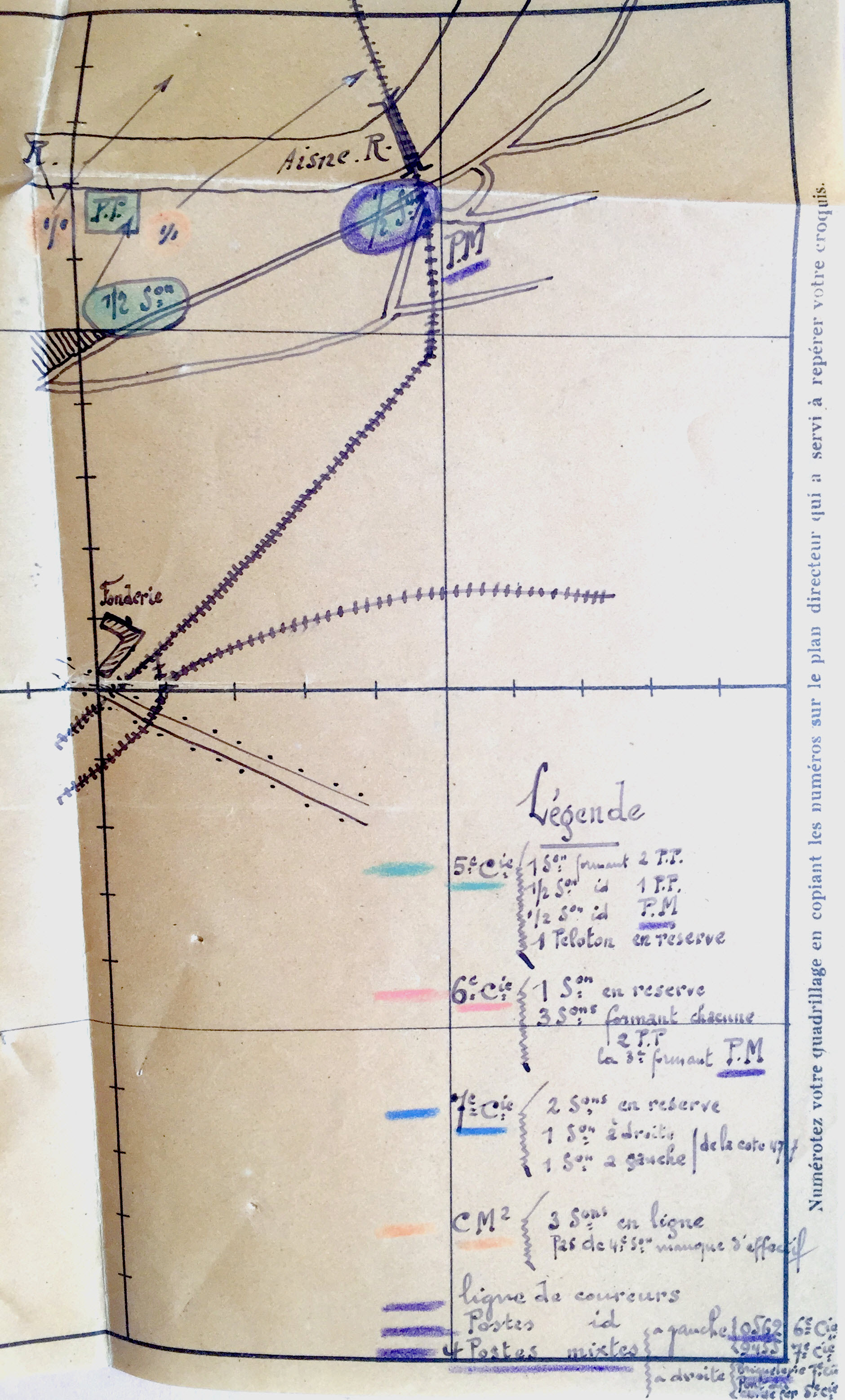


Sketches of the 151 RI positions near Villeneuve - Saint Germain in July - August 1918.
3 August: At dawn the enemy opens fire from the northern water’s edge, which it occupies. At 0810 hrs, the regiment is ordered to solidly establish itself on the norther and northeast borders of the Belleu plateau, with an advance-guard battalion at Villeneuve – Saint Germain and the railroad bridge. The 162 RI to the right does the same and sends one of its battalions to occupy the area of Ouvrage du “Mamelon Vert”. A platoon from 1 Co. and half 1 MG Co. is sent to the railroad bridge over the Aisne (west of Villeneuve – Saint Germain) to ascertain the state of the bridge. The 2 and 3 Cos. detach a section each towards Villeneuve – Saint Germain to surveille the river. Reconnaissance by the 1 Bat. reports that the enemy occupies the bridge head on the right bank of the Aisne and that it received gunfire from the houses southeast of St. Medard, 300 meters from the bridge.
The liaison is established with the 2 BCP on the left. Elements from 1 Bat. make several attempts to cross the Aisne but are driven back by heavy enemy fire. Enemy artillery bombards heavily all important points using all calibers of shells. At night, 3 Bat. is placed behind the 1 Bat. and occupies the center of Montfendu. The 2 Bat. goes to bivouac in the ouvrage east of Vignolles, occupying the large cavern. In sum, at the end of the day the regiment is arranged as follows: 1 Bat. with its three companies accoladed and echeloned in depth along the canal, 3 Bat. in support with 10 Co. at Côte 94, 9 Co. along the railway, 11 Co. in Tranchée Saint Geneviève, the 2 Bat. with all its units sheltering in the cavern at the ouvrage east of Vignolles. The regimental PC has been established behind this point. Losses include 2 killed and 10 wounded. Lieut. Nicot (3 MG Co.) is evacuated and Sous-Lieut. Martin (2 MG Co.) is gassed.
4-8 August: Enemy artillery remains highly active all day. The German infantry is very vigilant, listening posts are placed immediately along the north (right) bank of the Aisne and canal. The enemy also occupies the island. Numerous machine-guns open fire on certain listening posts, when a whistle is blow to warn lookouts. The situation for the regiment is that it is in the center of a half-circle with the enemy occupying the entire circumference, making any movement impossible during the day. Losses on 4 August include 3 killed and 4 wounded (incl. Lieut. Bugnot of 2 Co.). A day passes and the enemy seems decided to remaining on the defensive, firing artillery on even the smallest group spotted and systematically bombarding important points in the sector. Losses on 5 August include 1 killed and 7 wounded (including 2 gassed).
On 6 August, the enemy erects barbed-wire entanglements. He occupies, at least during the night, the southern bank of the canal which he flanks perfectly from the embankment east of the hydraulic pump, which is composed of several buildings transformed into fortresses. Sous-Lieuts. Girot, Houdin and Nicot are assigned to the 500 RAS. Sous-Lieut. Roger is transferred from 9 Co. to 3 MG Co. Losses on 6 August include 3 wounded. On the night of 7 August, enemy artillery bombards the regiments positions with Mustard gas, with 600-800 gas shells falling to the south of the Soissons – Reims road. Losses on 7 August include 3 wounded (including 1 gassed) and 3 missing. The next evening gas shells are fired on area around Saint Geneviève, along with bursts of machine-gun fire. Losses on 8 August include 6 wounded (including 5 gassed) and 1 missing.

The hydraulic pump on the Aisne Canal, at Villeneuve - Saint Germain.
9-25 August: An operation is planned for 1400 hrs with the objective of taking the hydraulic pump from the enemy. At 1400 hrs, 2 Co. sets off behind a protective barrage. A large number German troops – seemingly not wishing to put up a fight – are seen fleeing along the north bank of the Aisne Canal and disappear into a trench. Despite enormous amounts of machine-guns firing away on the flanks and escarpment, 2 Co. manages to take the fortress, capturing two prisoners from the 1st Bavarians. At this time, 3 Co. executes a movement and positions itself along the south bank of the canal. The artillery barrage on Villeneuve and Côte 94, unleashed starting at 1400 hrs, proves to not be effective. The machine-guns pour out a withering fire starting around 1440 hrs. At 1530 hrs, the Germans bombard the fortress with high-explosive and gas shells. A detachment of reinforcements arrives composed of 2 adjudants, 4 sergents, 8 caporaux, and 80 men. Lieut. Beaumont coming from CID is assigned to 5 Co., Sous-Lieut. Arnault coming from the CID is assigned to 6 Co. Losses include 3 killed, 14 wounded (including 4 gassed). The next day remains calm with some bursts of machine-gun fire at night and some artillery fire. During the night of 10-11 August, the 162 RI (at the center of the line) is pulled out of the sector. Losses on 10 August include 5 wounded.
In the second half of the night of 10-11 August, 1 Bat., after extending off to the right to allow for a battalion of 162 RI to be relieves, is itself relieved by 3 Bat. The 2 Bat. occupies the Vignolles cavern and is replaced by 1 Bat., with the former taking up the positions of 3 Bat. At the end of the night, the regiment is arrayed: in the first line at Villeneuve – Saint Germain quarter is 3 Bat. with three companies in line, accoladed. In the second line at Montfendu center is 2 Bat. In the third line is 1 Bat. at the Vignolles cavern. Lieut. Virleux coming from CID is assigned to 6 Co. Sdt. Jules Pont receives the Médaille Militaire. On the night of 11-12 August, 2 Bat. relieves the 2 BCP in the Soissons sector, with 5 Co. on the right, 6 Co. on the left and 7 Co. in support. 1 Co. of 1 Bat. relieves a battalion of 69 RI at la Buerie, while 2 Bat. is relieved by a company of 129 RI at Montfendu center. The following are awarded the Médaille Militaire: Sdt. Jean Segalen, Cpl. Jean Chelle, Sdt. Georges Dairaine, Sdt. Michel Balestra, Sdt. Lucien Auge, Sdt. Louis Bizel. Lieut. Le Tollect, previously wounded and evacuated returns to the regiment and takes command of the 37mm gun platoon. Sous-Lieut. Beffaras is transferred from 10 to 9 Co. Losses on 12 August include 1 wounded.
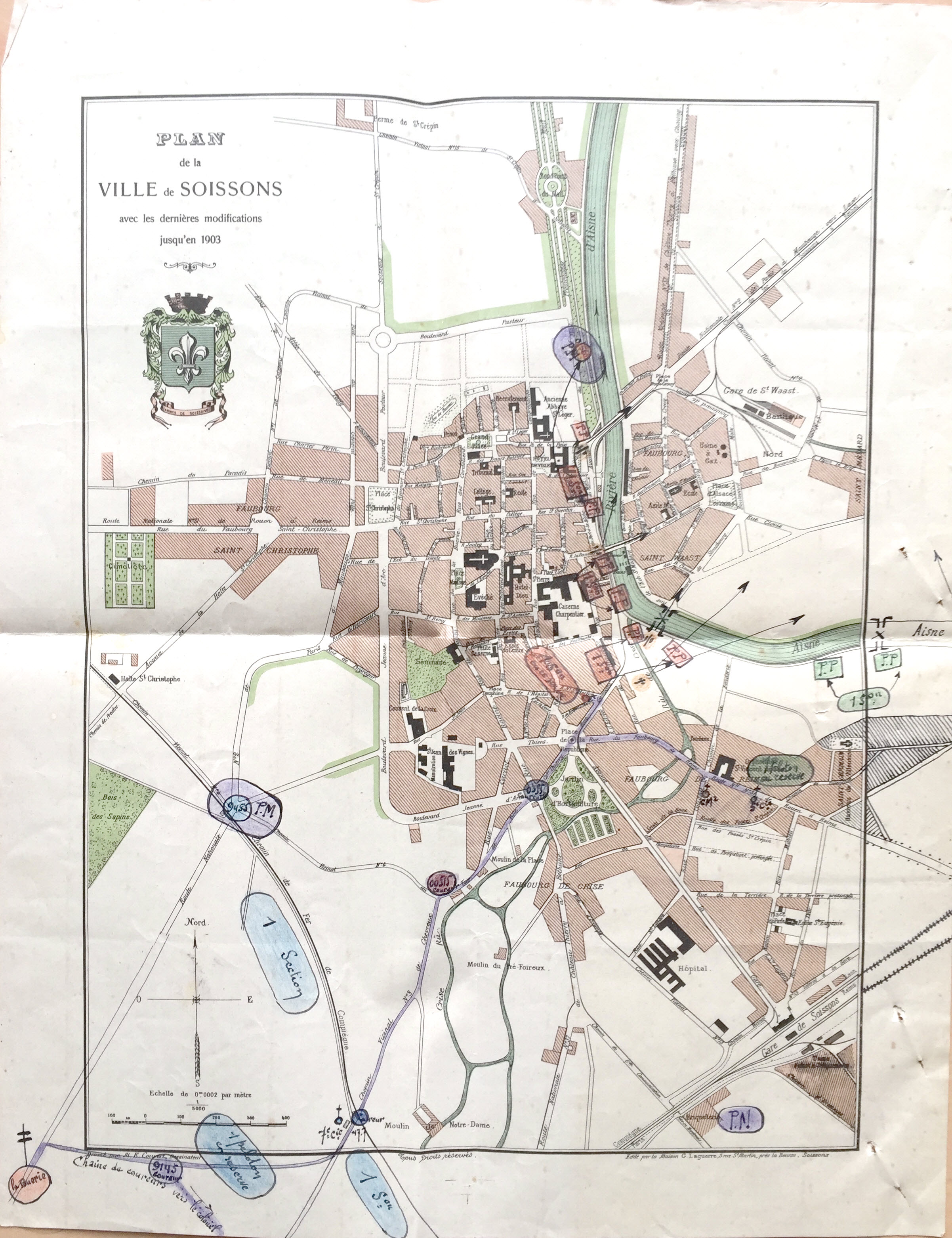
Map of Soissons showing the regiment's positions at the end of August 1918. (source: JMO 69 DI).
On 13 August the Germans bombard the Belleu ravine and environs with poison gas. The enemy erects barbed-wire entanglements between the Aisne and the Tranchée de l’Allemagne. Work continues on the entrenchments in Soissons. The commandant prescribes a study of how to cross the Aisne River and methods of preparing footbridges in collaboration with the engineers (rafts, footbridges, etc.). Sous-Lieut. Gatin transfers from the pioneers platoon (CHR) to 2 Co. Sous-Lieut. Bruno is transferred from 1 MG Co. (37mm gun platoon) to CHR (37mm gun platoon). Work continues on 14 August on the entrenchments in Soissons. A detachment of reinforcements coming from CID arrives composed of 1 aspirant, 1 adjudant, 1 sgt-fourrier, 9 sergents, 20 caporaux, and 106 men. Lieut. Beaumont coming from CID is assigned to 5 Co. and Sous-Lieut. Arnaud coming from CID is assigned to 6 Co. Losses include 8 wounded. Capt. LE Gall is evacuated due to illness and Lieut. Studer takes over command of 1 Co. in his place. The next night, the enemy can be heard actively working along the north bank of the canal. Losses on 15 August include 5 wounded. Enemy artillery is active on the night of the 16 August. Losses include 6 wounded.
Reciprocal artillery exchanges occur the next day and the regiment is told to be highly vigilant of the enemy and his positions. The previously studied means of crossing the Aisne, as well as the program for the immediate push afterwards, are to be circulated. Losses on 17 August include 1 killed and 3 wounded. The next day the enemy remains very quiet. The relief of the 161 by the 162 RI that was supposed to have occurred is cancelled owing to a particular mission being given to the latter. Losses include 3 wounded. On 19 August, the division to the left of the 69 DI carries out an attack. The 69 DI is instructed to anticipate a crossing of the Aisne by its own regiments in case the enemy falls back and engineers are ordered to establish footbridges. Losses include 1 wounded. The next day the enemy is more active and highly vigilant in the wake of the French attack on the left. The 1 Bat. is ordered to conduct reconnaissance at night in order to feel out the enemy and what course he would take if in retreat. Losses on 20 August include 2 wounded.
On 21 August, the 1 Bat. reconnaissance discovers that from Boyau Garibaldi to Tranchée Barbot on the left bank of the Aisne are acting as an observation line for the enemy, while the right bank of the Aisne is strongly occupied. A strong presence of PP machine-guns and minenwerfers. There is a strong bombardment around Venizel while to the regiment’s left the Germans have crossed back over the Aisne to St. Crepin-en-Choye. The 3 Bat. is relieved in the Villeneuve quarter by 1 Bat, the latter going back to the Vignolles cavern. Losses on 22 August include 5 wounded. Artillery is active the next night as the enemy bombards the regiment’s first lines in Soissons. Harassing machine-gun and mortar fire as well. In the night of 22-23 August, the battalion in line will send small detachments over the Aisne River to verify the enemy’s presence as there is a suspicion the enemy might have pulled back. Capt. Caisez is brevetted to battalion leader. Losses include 5 wounded.
The enemy keeps up an active fire with rifles, machine-guns and artillery. The regiment’s attempts to cross over the Aisne are largely kept in check but a detachment from 1 Co. manages to make it to the other side, capturing a prisoner in the trench north of the canal, near the hydraulic pump (6 Regiment of Chasseurs a Cheval). The enemy appears to be holding Saint Waast, Saint Médard, as well as the heights to the east of Cuffies. The day remains relatively calm though the enemy sends over 210 shells into Soissons. At night 3 Bat. relieves a battalion of the 418 RI and a unit of a Pacific Battalion at faubourg Saint Christophe. Losses on 23 August include 2 wounded. The next day the enemy sends over a great number of winged bombs on the regiment’s lines, as well as 210s on Soissons. In the evening, the Germans destroy the remaining section of the footbridge 14-59, probably by mortar fire. The PC of the regiment moves to Chateau Chevreux. The 2 Bat. is in the first line at Soissons, 3 Bat. is at Saint Christophe, and 1 Bat. in support at la Buerie – 14 Maisons. Losses include 2 wounded. On 25 August, the general commanding the 69 DI arrives at the regiment’s PC and holds a briefing with Lieut.-Colonel Perchenet and all the superior officers of the division to discuss an attack set for the morning of 27 August to be carried out by the 69 DI in collaboration with other divisions. The objective will be the area of Laffaux. Losses on 25 August include 4 wounded.




